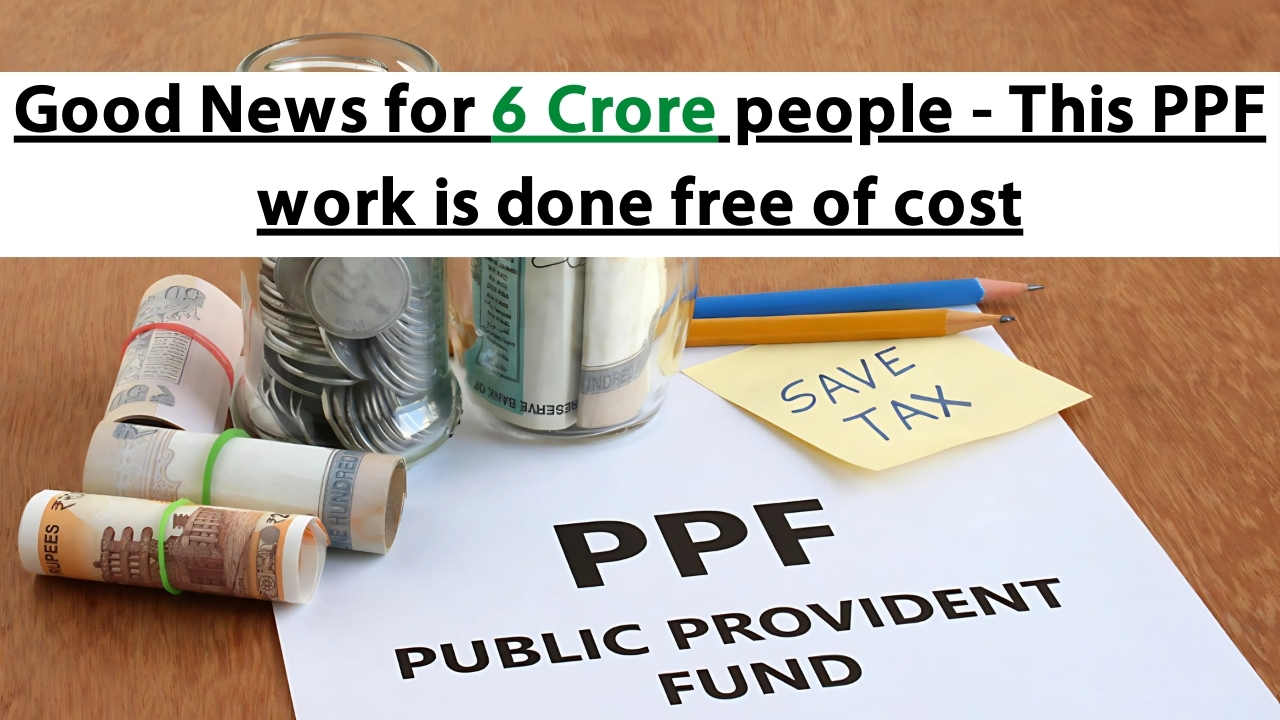PPF : In a welcome move that will benefit around 6 crore Public Provident Fund (PPF) account holders across the country, old PPF account holders will now get many PPF-related services without any charge.
With this policy revision, the various charges that acted as an entry barrier for multitude of subscribers – especially from middle and lower-income segments, who use PPF as their primary long-term saving instrument – will be dispensed with.
The initiative is part of broader efforts to boost financial inclusion and lower transaction costs for small savers.Increasing digital penetration in government-sponsored savings schemes.
PPF Major Services Are Now Free of Charges
The most significant change is the complete removel of processing fees or service charges for many regularly-used PPF services. Some specific services just freed include:
Having multiple years of account statements generated and fetched now does not mean charges of Rs. 50-100 will be levied, as previously was done for requesting complete accounts statement with details for more than one financial year or needing to extract older records.
This is particularly beneficial to those keeping physical accounts or needing documentation for taking loans and financial planning.
Standalone PPF accounts can be transferred free of cost between authorised banks and post offices, instead of the usual 100-500 transfer fee levied by most institutions.
This reform helps subscribers who move houses, or prefer to have all of their banking accounts under one roof, but were incurring a financial penalty for transferring their PPF accounts.
Nomination modification for which a processing fee was charged, between Rs. 50-100 according to the establishment, is absolutely free now.
Due to the importance of beneficiary designation to estate planning purposes, this critical service was frequently put off by account holders because of costs associated with this process.
Such dormant PPF accounts, where contributions had ceased, can be revived now without revival fees. In the past, in order to reactivate dormant accounts, users were asked to pay a sum ranging from anywhere between Rs. 100-250, which proved to be a deterrent for subscribers who had temporarily stopped making regular contributions on account of financial stress, but wanted to start saving again.
“The changes directly mitigated transaction costs disproportionately affecting small savers,” said Rajesh Sharma, a financial inclusion expert.
“As far as policymakers were concerned, the fees may have seemed nominal, but for individuals from low-income segments that are the very target demographic for PPF, these fees often represent meaningful amounts.”
PPF Cost Reduction: Pushed Generalized by Digital Transformation
The removal of these charges is part of an overarching digital overhaul of the processes around PPF accounts. Inbuilt technological infrastructure has drastically lowered the processing costs of financial institutions, rendering the operating efficiencies necessary for free delivery of services possible.
Our modern PPF management platform incorporates the latest technology to deliver efficiencies across the system:
It was possible through the current integrated verification systems that automatically validate subscriber [customer] identity using Aadhaar-based authentication and PAN linkage, thus avoiding those manual verification steps and eventually the processing costs associated with them.
This vastly decreases administrative overhead and strengthens by enabling multi-factor validation.
The centralized database architecture serves as the replacement of the disjointed record-keeping systems in numerous banks and post offices.
This consolidation allows for immediate access to account information much as the manual intervention and cross-institutional “alacrity” that once made processing credit cards at all justifiable.
Algorithmic processing of routine service requests, rather than manual processing, is used to manage automated workflow.
This automation greatly decreases staff requirements for basic services, which translates into savings that financial institutions are today passing through to consumers by waiving fees.
“The upgraded infrastructure changes with the economic model for service delivery,” said a senior official who was part of the implementation.
“A service that used to take a lot of manual work to process now runs automatically with a negligible marginal cost … zero-fee delivery is now economically viable for institutions.”
PPF Who Benefits From The Loan? Beneficiary Profiles
All 6 crore PPF account holders, of course, benefit from these changes, but certain demographic segments have more to gain than others from the abolition of the fee:
Rural account holders, who already had the compound challenge of distance, limited banking hours and service charges, are now witnessing massive friction removal.
For rural subscribers, even nominal fees formed significant barriers when compounded with transportation costs and wage losses stemming from making the journey to faraway bank branches during office hours.
Senior citizens keeping PPF account even after its maturity can enjoy simplified mode of account maintenance without any repeat charges. Often this group will need account statements and nominations updated, as part of wider estate planning, services that are now available for free.
Those migrant workers who have PPF accounts in their home places but are working in different places can now transfer the accounts to their place where they are currently working, without facing any financial loss.
This flexibility enhances labour mobility while ensuring the continuity of the savings pot, and it addresses a particular problem faced by India’s large community of internal migrants.
For young professionals just starting with their first PPF account, less barriers to account management is a godsend during their crucial saving years. For this class of people who had typically low starting incomes, even a small amount of fees at times discouraged the use of the PPF account itself.
“It just snowballs from the direct financial saving from the fees being eliminated,” said Dr. Priya Mehta, a consumer finance researcher. An associated psychological barrier — paying for basic account services — frequently acted as an impediment to active participation in P.P.F. accounts.” It creates more utilization consistency and contribution.”
PPF Proposed Process and Timeline for Implementation
The deployment is in a phased approach designed to ensure continuity of service. The changes are already in place for digitally processed requests at any of the participating institutions, and for requests made in person there is a transition period of two weeks as branch-level systems catch up with the zero-fee request structure.
For subscribers, there is nothing any user must do, as fee structures update seamlessly within institutional systems. Despite this, account holders must be aware that services outside of normal account maintenance may incur relevant charges in accordance with institutional policy.
It involves training all customer-facing staff on the new policies, so they are applied consistently across different channels of service delivery. This adoption of a template directly addresses historical inconsistencies where indeed, fee applications would differ even for branches of the same institution.
“It’s a seamless transition with no confusion and no service interruption,” a bank official involved in the rollout said of the implementation. “For subscribers, these changes should feel like a simple elimination of fee(s) without additional processes or paperwork/requirements.”
PPF Wide ranging impact on small savings ecosystem
In addition to the immediate gains for existing PPF subscribes, this change in policy has significant implications for the larger small savings universe in a few ways:
This increased usage was higher friction and cost in terms of the existing 6 crore account holders, which these recent developments would change. Initial feedback from pilot implementations shows that transaction volumes are up approximately 5–7% after the fees are eliminated, indicating service demand that was previously unsatisfied.
The strong value proposition of PPF, in terms of cost, may create competitive pressure on private financial products. At the same time, if private providers are forced to raise their game to compete, this could be beneficial to consumers of financial products more widely.
Standardisation across the schemes looks certain with similar free service models also on the cards for other government-backed savings schemes including Sukanya Samriddhi Yojana and Senior Citizens Savings Scheme. Harmonisation would have ensured uniformity across the government-sponsored small savings corpus.
Another likely effect of free digital offerings — and greater digital adoption incentives to such Promoters — among traditionally non-digital users. This transition also underpins broader financial inclusion goals, beyond short-term fee cuts.
“The elimination of the PPF fee could potentially spur similar consumer-friendly changes throughout other adjacent financial services,” said financial policy analyst Vikram Desai. “When flagship programs successfully eliminate fees without undermining institutional viability, powerful precedents are set for broader reform.”
PPF Where to From Here: Other Proposed Reforms
In the wake of these changes, authorities have identified a number of further reforms related to the PPF that are currently under consideration for future implementation:
Abandonment of the requirement of physical withdrawals and deposits, through mobile-first service delivery with a purpose-built PPF app that would facilitate all account management functions through smartphone interfaces, which has already begun to reduce dependence on physical visits to their branch.
This feature would, in particular, help subscribers in regions with poor banking infrastructure.
Enhanced financial planning tools include projection calculators, goalbased savings recommendations, and periodic contribution adjustment suggestions based on inflation rates and policy changes, integrated for PPF subscribers. PPF accounts can be made more functional than saving money in PPF accounts by giving these value-added services.
Simplifying documentation requirements and permitting interest rate adjustment to make the liquidity benefit of having PPF holding in your portfolio even more attractive while preserving the basic long term orientation of the PPF scheme.
The current fee eliminations, however, are just a first phase in a wider modernization plan, one official familiar with ongoing policy discussions suggested. “The goal is not just to make it cheaper but to materially improve PPF’s relevance for all segments of the population.”
For its about 6 crore existing PPF subscribers and potential future account holders, these changes are a definitive step towards a better product and infrastructure around long-term savings which is more accessible, efficient and user-friendly.
Implementation is now underway and as PPF users across the country adapt to the changes in the coming weeks the practical impact of these reforms will be increasingly evident in the wide range of contexts in which PPFs are used.
Also Read This-
-
New Bajaj Platina 110 launch with ABS and fabulous mileage
-
Shocking news for UPI Users – Check Extra Charges details
-
TATA Altroz – Racing look model launched with low cost



